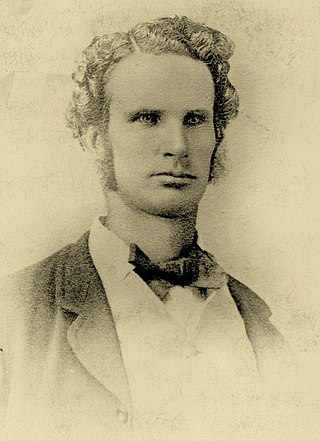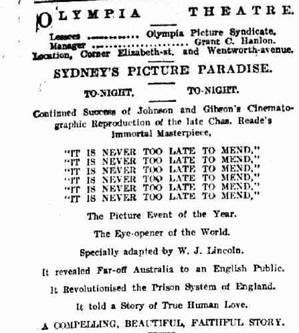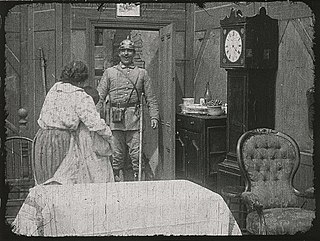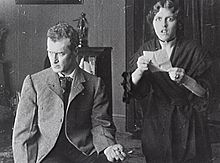
William Joseph Lincoln was an Australian playwright, theatre manager, film director and screenwriter in the silent era. He produced, directed and/or wrote 23 films between 1911 and 1916.

Adam Lindsay Gordon was a British-Australian poet, horseman, police officer and politician. He was the first Australian poet to gain considerable recognition overseas, and according to his contemporary, writer Marcus Clarke, Gordon's work represented "the beginnings of a national school of Australian poetry".

John F. Gavin was a pioneer Australian film actor and director, one of the early filmmakers of the 1910s. He is best known for making films about bushrangers such as Captain Thunderbolt, Captain Moonlite, Ben Hall and Frank Gardiner. Known informally as 'Jack', Gavin worked in collaboration with his wife Agnes, who scripted many of his films.
Frank Beaumont "Beau" Smith, was an Australian film director, producer and exhibitor, best known for making low-budget comedies.

Alfred Rolfe, real name Alfred Roker, was an Australian stage and film director and actor, best known for being the son-in-law of the celebrated actor-manager Alfred Dampier, with whom he appeared frequently on stage, and for his prolific output as a director during Australia's silent era, including Captain Midnight, the Bush King (1911), Captain Starlight, or Gentleman of the Road (1911) and The Hero of the Dardanelles (1915). Only one of his films as director survives today.

It Is Never Too Late to Mend is a 1911 Australian feature-length silent film written and directed by W. J. Lincoln.
La Revanche, also known as The Vengeance, is a 1916 Australian feature-length film directed by W. J. Lincoln about the revenge sought by Belgian friends of Edith Cavell against the Germans during World War I. It was a sequel to Nurse Cavell (1916), using many of the same cast and crew.
The Wreck is an Australian film directed by W. J. Lincoln based on a poem by Adam Lindsay Gordon about the ride to help by a farmhand who has witnessed a shipwreck. It is considered a lost film.
The Sick Stockrider is a 1913 film directed by W. J. Lincoln based on the 1870 poem of the same title by Adam Lindsay Gordon. It was the first production from Lincoln-Cass Films and is one of the few Australian silent films to survive in its entirety.
Called Back is a 1911 Australian feature-length film directed by W. J. Lincoln based on a popular play which was adapted from an 1883 novel by Hugh Conway. Although the movie was a popular success it is now considered a lost film.
The Luck of Roaring Camp is a 1911 Australian feature-length film directed by W. J. Lincoln now considered a lost film. It was highly regarded in its day, in part because it was based on a play that was popular with audiences.
Within Our Gates, also known as Deeds that Won Gallipoli, is a 1915 Australian silent film about Australia's fight with the German Empire and the Ottoman Empire during World War I, including the landing at Gaba Tepe during the Gallipoli campaign. The story was partly based on a play The Man Who Stayed at Home.

The Joan of Arc of Loos is a 1916 Australian silent film shot by Franklyn Barrett based on the true story of Émilienne Moreau-Evrard in World War I. Only a portion of the movie survives today.
Amalgamated Pictures Ltd was a film exchange company in Australia.
J. C. Williamson Film Company was a short-lived Australian film production company in the 1910s. It was part of the theatrical firm J. C. Williamson's, and produced a number of feature films during 1914-1918.
The Austral Photoplay Company was a short lived Australian production and distribution company. It was established in Melbourne in 1913 by A. C. Tinsdale and later transferred to Sydney in 1917. It initially sought to raise £10,000 to make a film about the goldfields.
Charles Moore and Co. was a company based in Adelaide, South Australia which owned a number of department stores in three Australian states. It was founded by Irish-born businessman, Charles Moore. Its best-known assets were the department store known to two generations of Adelaideans as "Moore's on the Square", Charles Moore's on Hay Street, Perth, Western Australia and Read's in Prahran, Victoria.
Constance Elizabeth Martyn was an Australian actress of stage and screen best known for playing Ma Rudd in Dad and Dave Come to Town.
Ruth Sutherland (1884–1948), was an Australian painter and art critic. She was a founding member of the Twenty Melbourne Painters Society.
A Romance of the Burke and Wills Expedition of 1860 is a 1918 Australian silent film. The plot is fictional and is loosely based around the Burke and Wills expedition.






